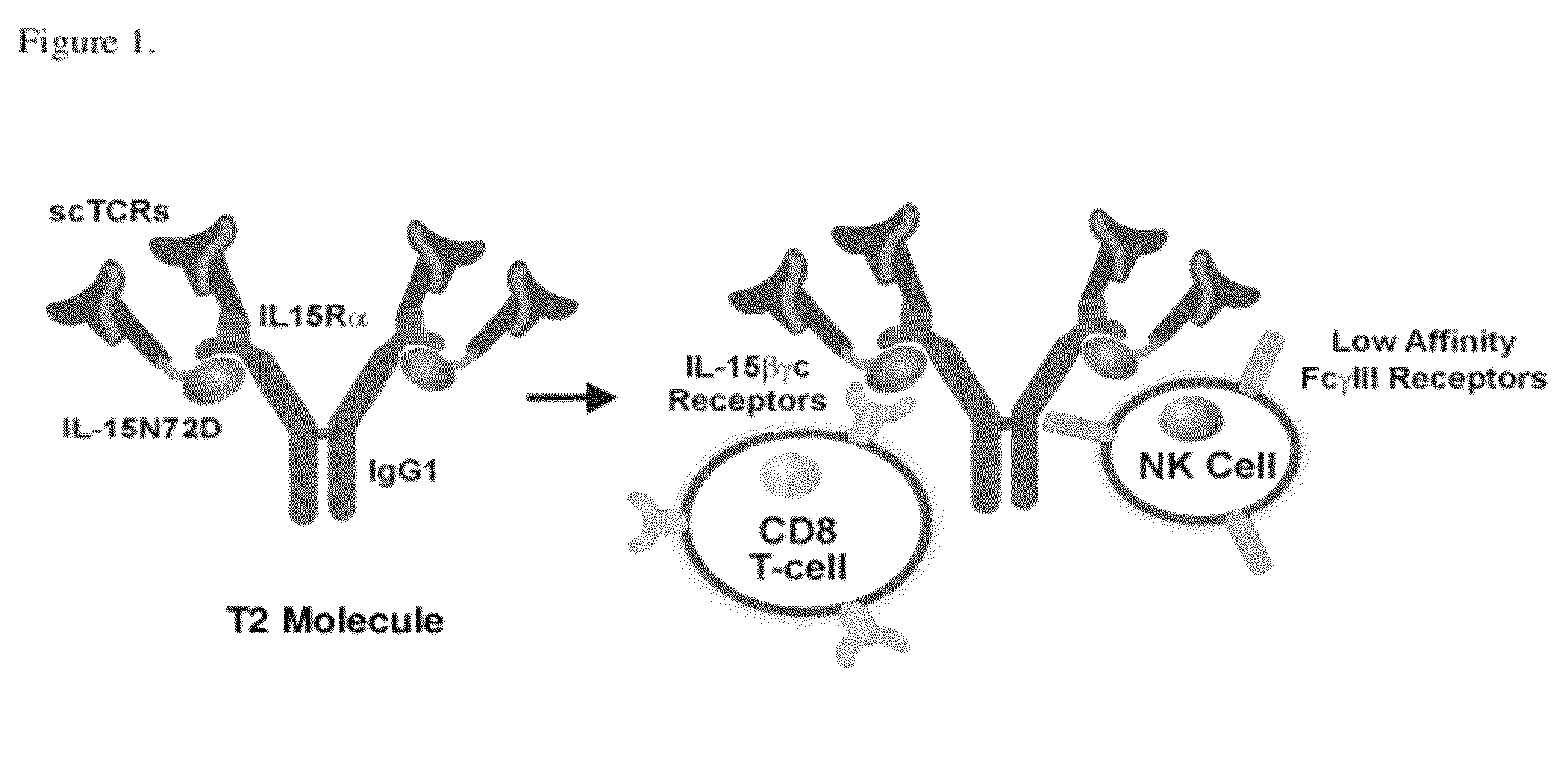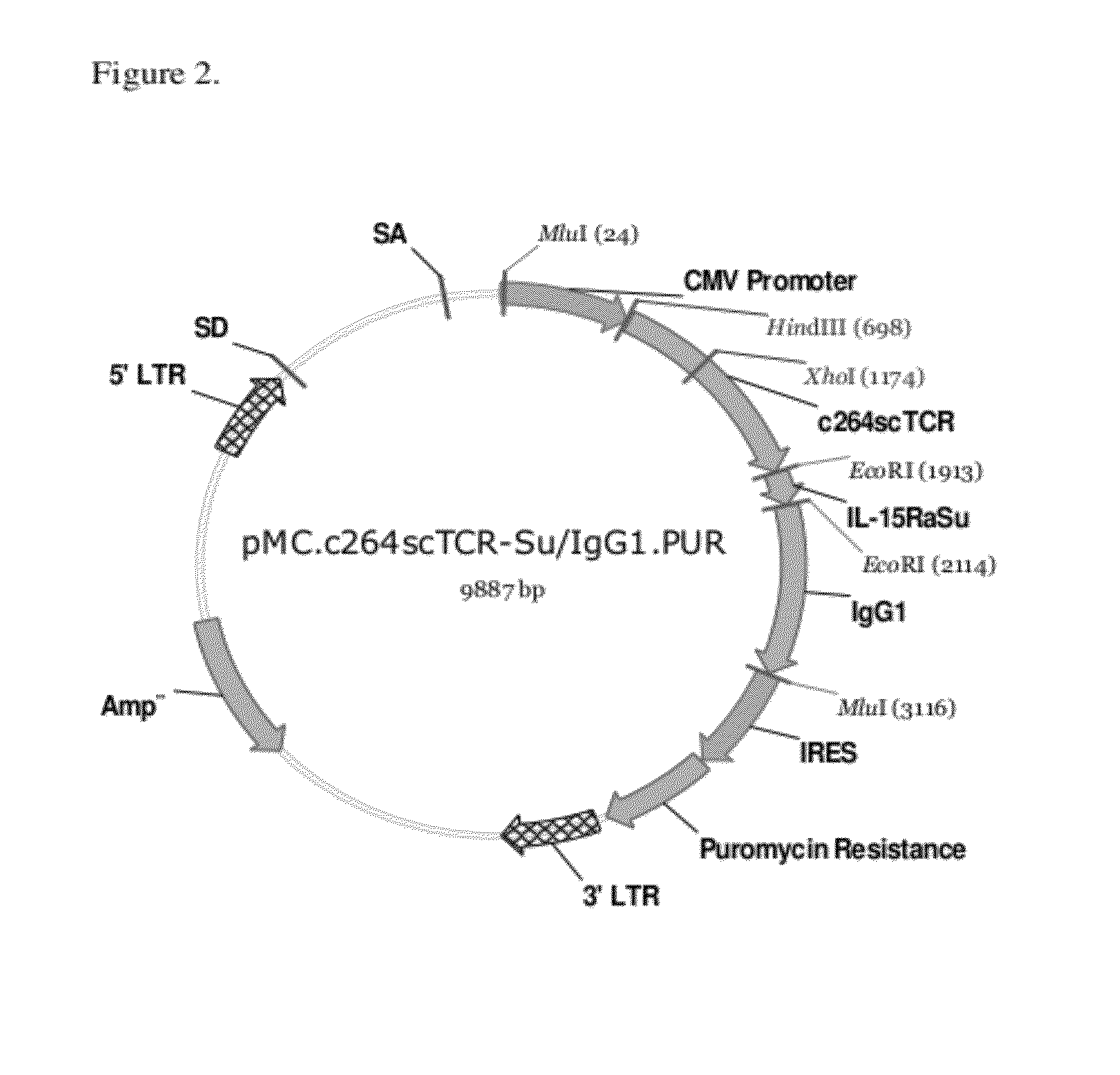Multimeric IL-15 soluble fusion molecules and methods of making and using same
a soluble fusion and multi-molecular technology, applied in the direction of fusion polypeptide, peptide/protein ingredients, dna/rna fragmentation, etc., can solve the problems of complicated purification process, low yield, difficult to scale up, etc., and achieve the effect of increasing the activity per molecule of il-15
- Summary
- Abstract
- Description
- Claims
- Application Information
AI Technical Summary
Benefits of technology
Problems solved by technology
Method used
Image
Examples
example 1
Construction of Expression Vectors Containing c264scTCR / huIL15RαSushi-huIgG1 and c149scTCR / huIL15N72D Gene Fusions
[0263]The fusion protein referred to as the T2 molecule (T2M) consists of a multichain polypeptide (FIG. 1). In one embodiment of the invention, one of these polypeptides comprises a fusion between a protein-binding domain and IL-15 (or IL-15 variants) as disclosed in WO2008143794 (incorporated herein by reference). A second polypeptide of T2 comprises a fusion between a protein binding domain, an IL-15Rα domain and an immunoglobulin domain. Alternatively, the protein binding domain-IL-15 fusion protein can be further linked to an immunoglobulin domain. The preferred immunoglobulin domains comprise regions that allow interaction with other immunoglobulin domains to form multichain proteins. For example, the immunoglobulin heavy chain regions, such as the IgG1 CH2-CH3, are capable of interacting to create the Fc region. Preferred immunoglobulin domains also comprise regio...
example 2
Generation of Transfected Host Cell Lines Producing Fusion Proteins
[0308]The expression vectors can be introduced into a variety of host cell lines by several different transformation, transfection or transduction methods. In one such method, CHO-K1 cells (5×105) were seeded in a 6-well plate and cultured overnight in a CO2 incubator. The cells were transfected with 5 μg of expression vector containing the c264scTCR / huIL15N72D fusion genes using 10 μL of Minis TransIT-LT1 reagent (Mirus) according to the manufacturer's protocol. The cells were selected with 4 mg / mL of G418 (Invitrogen) one day after the transfection. The G418 resistant cells were expanded and TCR / IL15 fusion protein expressing cells were subcloned three times by the limiting dilution and production cell lines were screened based on the level of soluble fusion protein secreted into the culture media by TCR and huIL15-specific ELISA with a capture antibody, anti-human TCR Cβ antibody (BF1), and a detection antibody, b...
example 3
Generation and Purification of T2 Fusion Proteins
[0310]Cell lines expressing c264scTCR / huIL15N72D and c264scTCR / huIL15RαSushi / huIgG1 were cultured under growth conditions (i.e. 25-37° C. for 5 to 28 days in small scale culture flasks, spinner or shaker flasks or in large scale hollow-fiber, wave bag or stir tank bioreactors or equivalent culture vessels and reactors) to produce the T2 molecule as a soluble protein in the culture media. To purify the T2 molecule the culture media was pH-adjusted and loaded on to an immunoaffinity column containing an anti-TCR antibody (BF1) covalently coupled to Sepharose. The column was washed and T2 molecules eluted with 0.5 M Na-citrate pH 4.0. The eluted protein was concentrated and buffer exchanged into phosphate buffered saline (PBS) and then loaded on rProtein A-Sepharose column. Following wash steps, the protein was eluted with 0.5 M Na-citrate pH 4.0 and then buffer exchanged into PBS. The resulting protein was characterized by Coomassie-sta...
PUM
| Property | Measurement | Unit |
|---|---|---|
| molecular weight | aaaaa | aaaaa |
| temperature | aaaaa | aaaaa |
| ionic strength | aaaaa | aaaaa |
Abstract
Description
Claims
Application Information
 Login to View More
Login to View More - R&D
- Intellectual Property
- Life Sciences
- Materials
- Tech Scout
- Unparalleled Data Quality
- Higher Quality Content
- 60% Fewer Hallucinations
Browse by: Latest US Patents, China's latest patents, Technical Efficacy Thesaurus, Application Domain, Technology Topic, Popular Technical Reports.
© 2025 PatSnap. All rights reserved.Legal|Privacy policy|Modern Slavery Act Transparency Statement|Sitemap|About US| Contact US: help@patsnap.com



